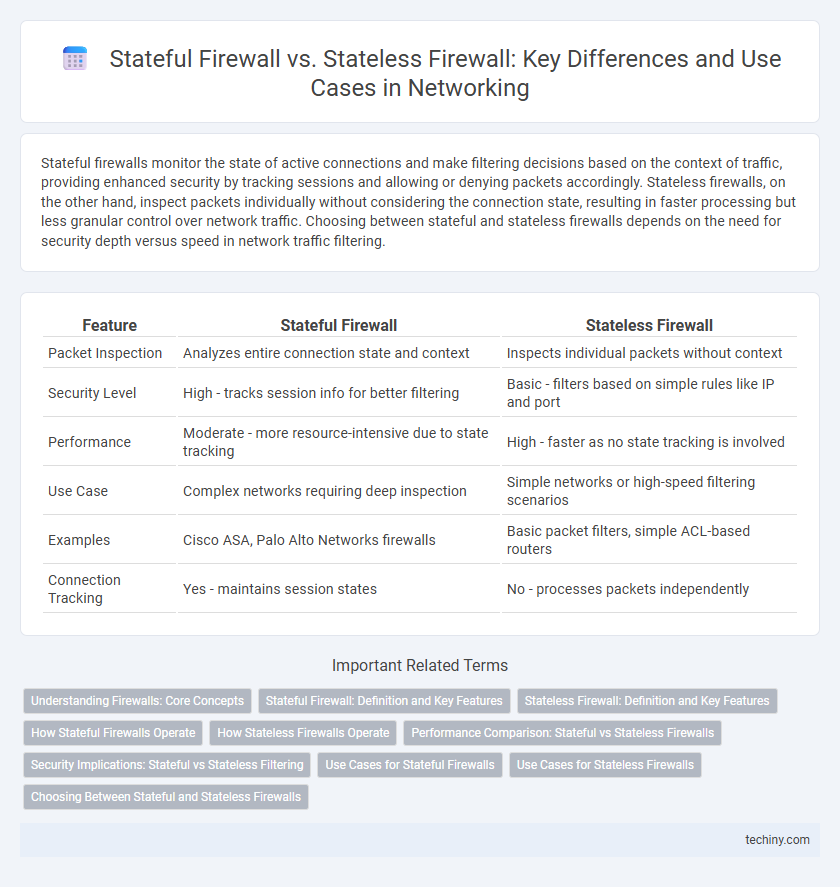Stateful firewalls monitor the state of active connections and make filtering decisions based on the context of traffic, providing enhanced security by tracking sessions and allowing or denying packets accordingly. Stateless firewalls, on the other hand, inspect packets individually without considering the connection state, resulting in faster processing but less granular control over network traffic. Choosing between stateful and stateless firewalls depends on the need for security depth versus speed in network traffic filtering.
Table of Comparison
| Feature | Stateful Firewall | Stateless Firewall |
|---|---|---|
| Packet Inspection | Analyzes entire connection state and context | Inspects individual packets without context |
| Security Level | High - tracks session info for better filtering | Basic - filters based on simple rules like IP and port |
| Performance | Moderate - more resource-intensive due to state tracking | High - faster as no state tracking is involved |
| Use Case | Complex networks requiring deep inspection | Simple networks or high-speed filtering scenarios |
| Examples | Cisco ASA, Palo Alto Networks firewalls | Basic packet filters, simple ACL-based routers |
| Connection Tracking | Yes - maintains session states | No - processes packets independently |
Understanding Firewalls: Core Concepts
Stateful firewalls monitor the full state of active network connections and make decisions based on the context of traffic, providing enhanced security by tracking sessions and allowing legitimate packets through. Stateless firewalls inspect packets individually without considering the state or context, resulting in faster processing but less granular control. Understanding the fundamental difference between stateful and stateless firewalls is key to designing effective network security architectures that balance performance and protection.
Stateful Firewall: Definition and Key Features
A stateful firewall tracks the state and context of active network connections, enabling it to make more informed decisions by examining the entire session rather than individual packets alone. It maintains a state table that records connection details such as source and destination IP addresses, port numbers, and connection status, which allows it to detect anomalies and prevent unauthorized access effectively. Key features of stateful firewalls include dynamic packet filtering, enhanced security through deep packet inspection, and the ability to support complex protocols and applications that require continuous communication monitoring.
Stateless Firewall: Definition and Key Features
A stateless firewall operates by filtering packets individually based on predefined rules without considering the state of network connections, enabling faster processing but less context awareness. Key features include rule-based packet inspection, simplicity in configuration, and reduced resource consumption compared to stateful firewalls. Stateless firewalls are ideal for high-speed environments where speed outweighs the need for detailed connection tracking.
How Stateful Firewalls Operate
Stateful firewalls operate by monitoring the state of active connections and making decisions based on the context of traffic, such as tracking TCP handshake processes and session information. These firewalls maintain a state table to record ongoing connections, enabling them to filter packets dynamically and allow only legitimate traffic associated with established sessions. This operation contrasts with stateless firewalls, which inspect each packet in isolation without regard to the connection state.
How Stateless Firewalls Operate
Stateless firewalls operate by inspecting packets individually without considering the context of previous packets, relying solely on predefined rules such as IP addresses, ports, and protocols. They evaluate each packet against access control lists (ACLs) and allow or block traffic based on these static criteria, which makes them faster but less secure compared to stateful firewalls. This method is efficient for basic filtering but lacks the capability to detect complex network threats involving session information or connection states.
Performance Comparison: Stateful vs Stateless Firewalls
Stateful firewalls maintain connection states and analyze entire data packets, providing robust security but requiring higher processing power, which can impact performance under heavy traffic. Stateless firewalls filter packets based on predefined rules without tracking connection states, resulting in faster processing speeds suitable for high-throughput environments but offering less comprehensive security. Performance optimization depends on network requirements; stateful firewalls prioritize security integrity, while stateless firewalls excel in speed and low latency.
Security Implications: Stateful vs Stateless Filtering
Stateful firewalls provide enhanced security by tracking the state of active connections and making filtering decisions based on context, which helps prevent unauthorized access and spoofing attacks. Stateless firewalls, however, filter packets solely based on predefined rules without considering connection states, making them faster but less effective against sophisticated threats like session hijacking or application-layer attacks. Implementing a stateful firewall is crucial for environments requiring robust security measures against evolving cyber threats.
Use Cases for Stateful Firewalls
Stateful firewalls are ideal for environments requiring thorough monitoring of active connections, such as enterprise networks and data centers where session awareness enhances security against complex threats. They effectively manage dynamic traffic by tracking packet state and context, making them suitable for applications involving VPNs, VoIP, and online banking systems. Stateful firewalls provide robust protection for multi-layered network infrastructures by analyzing protocol compliance and ensuring only legitimate, established sessions are permitted.
Use Cases for Stateless Firewalls
Stateless firewalls are ideal for simple network environments requiring high-speed packet filtering with minimal processing overhead, such as edge routers or DMZs where traffic patterns are predictable. They are effective in scenarios demanding rapid throughput and where maintaining connection states is unnecessary, like blocking specific IP addresses or ports in IoT networks. Stateless firewalls excel in protecting systems with limited resources or in environments focusing on basic access control rather than complex session management.
Choosing Between Stateful and Stateless Firewalls
Choosing between stateful and stateless firewalls depends on network security needs and traffic complexity. Stateful firewalls monitor active connections and provide dynamic filtering based on session state, offering enhanced protection against unauthorized access. Stateless firewalls inspect packets individually without connection context, delivering faster performance but less comprehensive security, making them suitable for high-speed, low-risk environments.
Stateful Firewall vs Stateless Firewall Infographic

 techiny.com
techiny.com